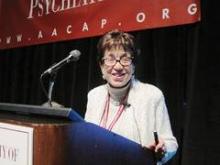NEW YORK – Treating children and teens with refractory bipolar disorder requires both persistence and faith, according to Dr. Gabrielle A. Carlson.
Although new data are trickling out, few of the medications available for treating both mania and depression have been extensively studied in children and teens, Dr. Carlson said at a psychopharmacology update held by the American Academy of Child and Adolescent Psychiatry.
"The first-generation antipsychotics have been grandfathered in with [Food and Drug Administration] approval. There are very little data for youngsters, and it’s unlikely that there ever will be, since they are generic now and no one will be spending the money" to further investigate them.
A few pediatric trials are in progress for some of the newer, second-generation antipsychotics, but most efficacy data are still from adult studies, said Dr. Carlson, professor of psychiatry and pediatrics at Stony Brook University, New York.
Most recently, paloperidone was found effective as an acute treatment for mania in children with bipolar disorder. But the open-label study was very small – just 15 patients – and was terminated early because of the slow enrollment. The study tested two doses (3 mg and 12 mg). There was a significant mean decline of almost 19 points on the Young Mania Rating Scale after 8 weeks of treatment. Children gained a mean of 4 pounds, however (Psychopharmacology [Berl.] 2013;227:449-58).
Sublingual treatment
Asenapine "is the new kid on the block," Dr. Carlson said. It was approved in 2009 for the acute treatment of schizophrenia and manic or mixed bipolar episodes in adults. It’s administered as a sublingual tablet that takes about 10 minutes to dissolve.
"This is good news if you’ve got a kid who has trouble swallowing pills. The bad news is that you have to hold it under your tongue for 10 minutes, and if you’ve got an aggressive, agitated kid – well, good luck with that. If he does it, though, you can get a good treatment response pretty quickly, because it has a peak concentration of 30-90 minutes and a half-life of about 24 hours."
The adult studies of asenapine showed a significant benefit in about 1 week, with many bipolar patients seeing a 50% reduction in symptoms. Two placebo-controlled trials in children are just wrapping up. The first, comprising 400 children, is complete, but no data have yet been published.
The second, a 50-week open-label study, is ongoing; about 300 children are enrolled.
In the adult studies of asenapine, the number needed to treat was about eight. "The NNT for many other drugs is four or five, so to me this looks like a contender, but not anything great. The sublingual route is the biggest benefit," although, Dr. Carlson cautioned, "it does make noncompliance a lot easier, just by swallowing it." The bioavailability when swallowed is only about 35%.
Asenapine is sedating, so it might be a good choice for as-needed treatment; the weight gain profile is similar to that of olanzapine. The twice-daily dosing is weight based, Dr. Carlson said. "Younger children are more sensitive to the initial dose, so they need a lower starting point and shorter up-titration, which isn’t necessary in the older kids."
For children with bipolar depression, there’s little evidence to support the use of quetiapine. There are no data in youngsters and few data to support its use in adults. A 2012 meta-analysis found that the drug is no better than placebo.
The combination of olanzapine and fluoxetine has been examined in children aged 10-17 years. The industry-sponsored placebo-controlled study treated 160 children for 8 weeks.
At the end of the study, remission rates were 59% in the active group and 43% in the placebo group – a significant difference. Children taking the combination gained significantly more weight than those taking placebo – an average of 4 vs. 0.5 kg. There were also significant increases in liver enzymes and prolactin in those taking the drugs, as well as a higher chance of prolonged QTc intervals.
Unpublished results of another study hint that lamotrigine also might be effective in children with bipolar depression, Dr. Carlson said.
The 8-week study looked at what happened to children aged 10-17 years who had lamotrigine withdrawn after they had responded to it. These patients were given the option of continuing the drug or switching to placebo.
"So far they have 250 enrolled," Dr. Carlson said. "Of these, 136 were willing to be randomized, meaning that at least 60% got better in the open-label phase."


